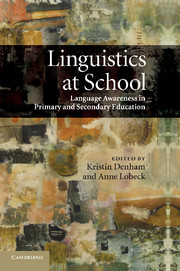Book contents
- Frontmatter
- Contents
- Notes on contributors
- Foreword: The challenge for education
- Introduction
- Part I Linguistics from the top down: encouraging institutional change
- Part II Linguistics from the bottom up: encouraging classroom change
- Part III Vignettes: voices from the classroom
- Introduction to Part III
- 16 And you can all say haboo: enriching the standard language arts curriculum with linguistic analysis
- 17 Code switching: connecting written and spoken language patterns
- 18 A primary teacher's linguistic journey
- 19 Why do VCE English Language?
- 20 Language lessons in an American middle school
- 21 The diary of Opal Whiteley: a literary and linguistic mystery
- 22 Using the Voices of North Carolina curriculum
- 23 A-level English Language teaching in London
- References
- Index
16 - And you can all say haboo: enriching the standard language arts curriculum with linguistic analysis
Published online by Cambridge University Press: 04 August 2010
- Frontmatter
- Contents
- Notes on contributors
- Foreword: The challenge for education
- Introduction
- Part I Linguistics from the top down: encouraging institutional change
- Part II Linguistics from the bottom up: encouraging classroom change
- Part III Vignettes: voices from the classroom
- Introduction to Part III
- 16 And you can all say haboo: enriching the standard language arts curriculum with linguistic analysis
- 17 Code switching: connecting written and spoken language patterns
- 18 A primary teacher's linguistic journey
- 19 Why do VCE English Language?
- 20 Language lessons in an American middle school
- 21 The diary of Opal Whiteley: a literary and linguistic mystery
- 22 Using the Voices of North Carolina curriculum
- 23 A-level English Language teaching in London
- References
- Index
Summary
When I enrolled in the first of two required linguistics courses as an undergraduate secondary language arts education student, I expected to be inundated with grammatical regulations and inane exceptions that had no ostensible rhyme nor reason. As predicted, I was reintroduced to the same laws of grammar that had tormented me as a highschooler. However, contrary to my expectations, my linguistics courses provided the tools to analyze the English language both prescriptively and descriptively. I began to understand the study of language as an intriguing science with evidence and variables that could be found all around me in conversations and literature. Grammar finally made sense and I wanted to empower my future students with this same sense of appreciation and comprehension of linguistic convention, practice, and history. As a result, I supplemented my Bachelor of Arts in Education with an additional undergraduate degree in Linguistics. Now, as a secondary English teacher of seven years, I find that I often return to my linguistic studies to enhance the standard language arts curriculum within the public school system.
Linguistic enrichment has found a constant home in my 11th-grade American Literature class, especially due to its melding of history and literature. In this course, we study major literary movements in the United States in chronological order, beginning with the first inhabitants. In preparation for our first unit, I present examples of how Native American languages have influenced English in the United States.
- Type
- Chapter
- Information
- Linguistics at SchoolLanguage Awareness in Primary and Secondary Education, pp. 234 - 239Publisher: Cambridge University PressPrint publication year: 2010



